ORGANIC PHOTOCHEMISTRY

Organic photochemistry is a powerful tool in the field of organic synthesis: this approach allows to perform chemical processes usually forbidden under thermal conditions by changing the properties of the molecules upon light absorption.
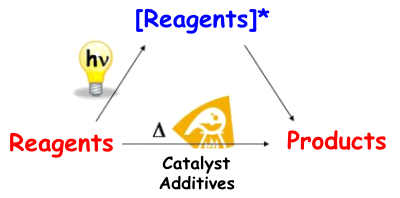
Nowadays, photochemistry is gaining more and more importance in the field of "Green Chemistry": actually, light can be considered a clean reagent since it activates the substrates leaving no residues in the reaction mixture. This allows for a simple work up and purification of the products. Thus, photochemistry appears as a valid alternative in the frame of sustainable development.
The research carried out in our laboratories focuses on two different targets. First, we try to devise innovative and new photochemical reactions and set up the best overall conditions to make them interesting for synthetic applications. Second, these syntheses are supported by mechanistic studies, where a deeper investigation of the reaction mechanism is looked for. This last target is fulfilled by means of both steady state spectroscopy (Absorption, Fluorescence and Phosphorescence), as well as by time resolved spectroscopy (Laser Flash Photolysis, Single Photon Counter), and by computational tools (softwares: Gaussian, Gamess, ADF and Molcas).
Photochemistry in our lab
Photochemistry is often considered as a different discipline with respect to traditional (thermal) chemistry. Actually, photochemical and thermal reactions employ two different approaches towards the same goal. This sharp distinction is usually seen as a barrier and makes photochemistry a rarely investigated subject (both in the academic field and in the industry). Despite its high synthetic potential (demonstrated by several examples present in the literature, e.g. A. Albini, M. Fagnoni Eds., "Handbook of Synthetic Photochemistry", 2009, Wiley-VCH, Weinheim), organic photochemistry is far from being fully exploited, except than by a small number of research groups.
Aim of this short section is describing a photochemical laboratory from the practical point of view, showing the main instruments that are usually employed and attempting to clarify what "making" photochemistry means and to bring this discipline closer to the generality of chemists.
Obviously, the main characteristic of a photochemical reaction is using light. In most cases, we use light sources emitting in the UV region and quartz tubes are thus required (see the picture below, left part). The lamps available in our lab are shown in the picture on the right: from top to bottom, a low pressure mercury lamp (emission at 254 nm), two "phosphor-coated" lamps (emission centered at 310 and 360 nm, respectively) a medium pressure mercury lamp (used for immersion reactors) and a high mercury pressure lamp.
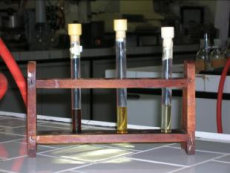 |
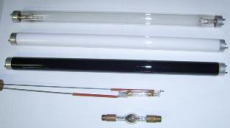 |
The different kinds of light sources can be composed according to the required experimental conditions having recourse to:
| Multi-lamp apparatus |
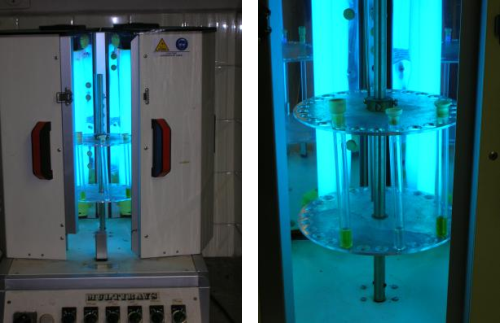 |
| Immersion reactor | Common lamp-holders |
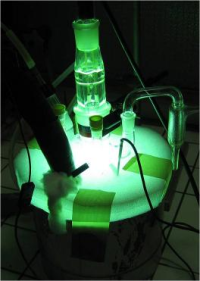 |
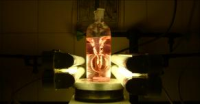 |
Sometimes, there is no need to use the UV radiation and the reactions can be conveniently carried out by using sunlight (that emits mainly in the visible part of the spectrum) and the glass reaction vessels can be exposed on the window ledge, as shown in the following picture.
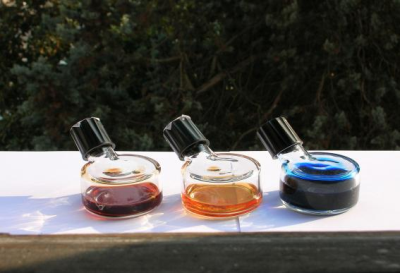
The solar radiation, however, is intermittent and varies according to the geographical position and the weather conditions. To overcome this drawback, we can use a solar simulator, which reproduces the solar radiation by means of a Xenon lamp; the following picture shows the "Solarbox" used in our laboratory.
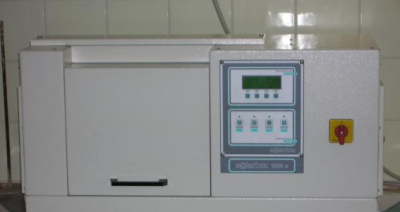
A thesis in our lab is like a typical thesis on organic chemistry. It is possible, however, to focus on the synthetic, mechanistic or applicative aspects of the processes.
- For more details on the research lines in our lab, go to the RESEARCH section

